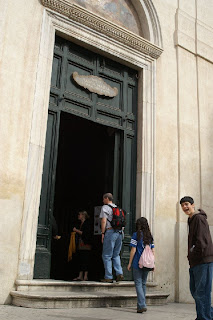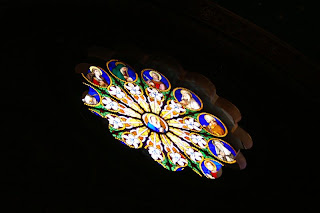 If you missed my previous two installments on Adventures in Rome, click here:
If you missed my previous two installments on Adventures in Rome, click here:The Beginning
The Middle
Now, in case you were wondering, there is another advantage/disadvantage to staying in an apartment vs. a hotel for a family of four.
Advantage: We had a nice big bathroom to use.
Disadvantage: We didn’t have a lovely maid service providing an endless supply of T.P., and even worse, we didn’t have Louie Da Plumber with us! (If you missed my blog post singing the praises of Louie Da Plumber click HERE.)
Yes, although my beloved plumber, Louie Valenti, is Italian, he wasn’t in Italy. And for some reason the apartment’s hot water heater circuit would trip on a daily basis. (Maybe that’s an electrical problem, but anyway…) It wouldn’t have been so bad except the circuit would typically trip mid-shower.
I knew from reading the tour books beforehand that we shouldn’t expect the long, hot showers we get in the U.S. But none of us were prepared for the mere minute-and-a-half showers we received. Typically, one of us would get in the shower, get all soaped and shampooed up, then BAM! The water would turn ice cold. We’d be forced to shiver our way through a super-fast rinse off.
 Then to add to our vacation pleasure, we ran out of T.P. (Two rolls for a family of four for eight days. Nah. Didn’t quite cut it.)
Then to add to our vacation pleasure, we ran out of T.P. (Two rolls for a family of four for eight days. Nah. Didn’t quite cut it.)
So my brave “non parla Italiano hubby” attempted to buy some at the grocery store. I say attempted because due to a helpful sales clerk who thought she knew what he wanted, he came back with paper towels instead.
That was, um, interesting.
Aaaaaanyway…back to our exploration of Rome.
We had pre-registered for a Wednesday tour of the famous Borghese Gallery. We arrived at 10:30 a.m. and checked in.
“Oh yeah! We can get audiotours!” I said excitedly pointing out the audiotour sign.
My entire family just blinked at me. “What for?” Joshua asked.
I gave an exasperated sigh. “So we know what we’re looking at!”
My family blinked again, then just strolled away.
Hmph! I got my audiotour anyway, which I shared with my son, much to his dismay.
We saw the action-oriented Bernini sculpture of David, from the famous David and Goliath story. I think this David is so much cooler than the typical just-standing-there David. Twenty-five-year-old Bernini used his own likeness to portray David’s face. In typical Baroque style, he’s in action. Biting his lip, focused expression, we witness him at the very moment he’s about to become a hero. And we also saw another famous Bernini sculpture taken from Greek & Roman mythology. This Apollo & Daphne sculpture portrays the moment Daphne has just cried out to her father to save her from the unwanted advances of the overly amorous Apollo. He grants her wish by turning her into a tree just as Apollo reaches her.
And we also saw another famous Bernini sculpture taken from Greek & Roman mythology. This Apollo & Daphne sculpture portrays the moment Daphne has just cried out to her father to save her from the unwanted advances of the overly amorous Apollo. He grants her wish by turning her into a tree just as Apollo reaches her. Leaving the museum, we strolled through the beautiful Borghese Gardens.
Leaving the museum, we strolled through the beautiful Borghese Gardens. Then back to the Spanish Steps and Trevi Fountain. There were SO many more people there during the daytime!
Then back to the Spanish Steps and Trevi Fountain. There were SO many more people there during the daytime! These cute Italian boys were attempting to ride this—this bike-thingy through the crowds. Give it up, boys!
These cute Italian boys were attempting to ride this—this bike-thingy through the crowds. Give it up, boys! Next we arrived at the Pantheon.
Next we arrived at the Pantheon. Constructed to honor all pagan gods, this temple was rebuilt in the 2nd century A.D. by Emperor Hadrian. The incredible dome was the largest ever designed until the 20th century. The Pantheon also offered audiotours, but my family made me skip this one.
Constructed to honor all pagan gods, this temple was rebuilt in the 2nd century A.D. by Emperor Hadrian. The incredible dome was the largest ever designed until the 20th century. The Pantheon also offered audiotours, but my family made me skip this one.
Located right nearby is Santa Maria sopra Minerva, the only major church in Rome built in Gothic style.
 It’s built over the ruins of a Temple of Minerva, goddess of wisdom. It’s also the home of Michelangelo’s famous Risen Christ. Unfortunately, as I previously mentioned, I’d forgotten our guide books. So although I had remembered wanting to visit this church, I couldn’t remember why. I got so busy taking artistic pics of the church’s interior…
It’s built over the ruins of a Temple of Minerva, goddess of wisdom. It’s also the home of Michelangelo’s famous Risen Christ. Unfortunately, as I previously mentioned, I’d forgotten our guide books. So although I had remembered wanting to visit this church, I couldn’t remember why. I got so busy taking artistic pics of the church’s interior…

 …I completely missed Michelangelo’s famous work. Sigh. I guess I’ll just have to be satisfied that I saw the Sistine Chapel and the Pieta.
…I completely missed Michelangelo’s famous work. Sigh. I guess I’ll just have to be satisfied that I saw the Sistine Chapel and the Pieta.
One thing I found particularly cool about sightseeing in Rome, was the opportunity to see the places where Bible stories I’ve read about actually took place. Like Mamertine Prison (Carcere Mamertino) for example. The apostles Peter and Paul were actually imprisoned there. It was a dank, dark, cramped space. We walked on the actual floor of their prison--touched the walls with our hands--that was SO COOL!
The apostles Peter and Paul were actually imprisoned there. It was a dank, dark, cramped space. We walked on the actual floor of their prison--touched the walls with our hands--that was SO COOL!
We also visited the Basilica of St. Peter-in-chains. This church holds the actual chains that bound Peter and Paul in Mamertine Prison, as well as a second set of chains that bound Peter when Herod jailed him in Jerusalem (Acts 12). Quick story summary: King Herod threw Peter in prison with plans to kill him later. One night, Peter was lying asleep between two snoozing Roman soldiers, bound in these chains. Even more guards were outside the door of the prison. Suddenly an angel appeared, struck Peter on the side, and his chains (THESE chains!) fell off his hands. The angel led him out of the prison to the city gate, which opened by itself, and Peter was set free. More coolness! There was a church service going on while tourists traipsed around the basilica, which felt kind of weird & disrespectful somehow, but the congregation seemed accustomed to it. On top of the historically significant chains, the basilica also is home to a sculpture of Moses, another famous work of Michelangelo’s.
There was a church service going on while tourists traipsed around the basilica, which felt kind of weird & disrespectful somehow, but the congregation seemed accustomed to it. On top of the historically significant chains, the basilica also is home to a sculpture of Moses, another famous work of Michelangelo’s. We came to Capitoline Hill and the Capitoline Museum. The Capitoline Museum was established in 1471, and it’s the oldest public collection in the world. I was thrilled to learn the museum offered audiotours, but when I asked I was told none of the English-speaking ones were available. I heard several very suspicious sighs of relief coming from my family behind me.
We came to Capitoline Hill and the Capitoline Museum. The Capitoline Museum was established in 1471, and it’s the oldest public collection in the world. I was thrilled to learn the museum offered audiotours, but when I asked I was told none of the English-speaking ones were available. I heard several very suspicious sighs of relief coming from my family behind me.
The courtyard of the museum is filled with massive chunks of an ancient sculpture of Emperor Constantine the Great, the first Christian emperor (306 – 337 A.D.). His head, hand and foot survived intact. The museum also contains the greatest surviving equestrian statue of antiquity—a statue of the Emperor Marcus Aurelius (161-180 A.D.). Many believe this statue was preserved so well because it was mistaken for a statue of the Emperor Constantine.
The museum also contains the greatest surviving equestrian statue of antiquity—a statue of the Emperor Marcus Aurelius (161-180 A.D.). Many believe this statue was preserved so well because it was mistaken for a statue of the Emperor Constantine. Our next stop was the Vittorio Emanuele II Monument, a.k.a. the Wedding Cake. This brighter-than-white structure was built as a monument to Italy’s first king and to commemorate the 50th anniversary of Italian unification.
Our next stop was the Vittorio Emanuele II Monument, a.k.a. the Wedding Cake. This brighter-than-white structure was built as a monument to Italy’s first king and to commemorate the 50th anniversary of Italian unification. We took the elevator to the top for an awesome 360-degree view of the city.
We took the elevator to the top for an awesome 360-degree view of the city.

 We’d seen the oldest equestrian statue in the world, and here was the biggest. The statue is 43-ft. long, and the king’s moustache alone is over five feet wide.
We’d seen the oldest equestrian statue in the world, and here was the biggest. The statue is 43-ft. long, and the king’s moustache alone is over five feet wide. After a quick gelato trip, we headed home to rest our aching feet. As we prepared for bed, Ashleigh was not a happy girl.
After a quick gelato trip, we headed home to rest our aching feet. As we prepared for bed, Ashleigh was not a happy girl. She discovered pavement ants in her bedroom. Ewwww! Quite curious since we were on the 7th floor, and we’ve never known pavement ants to live anywhere besides ground-level slabs. Maybe it’s an Italian thing, or maybe they got confused from all the earthquakes.
She discovered pavement ants in her bedroom. Ewwww! Quite curious since we were on the 7th floor, and we’ve never known pavement ants to live anywhere besides ground-level slabs. Maybe it’s an Italian thing, or maybe they got confused from all the earthquakes.
Stay tuned for more Adventures in Rome!
Italian Shower image
T.P. image by Bollin
Vittorio image by Argenberg
David image by smarthistory.org
Apollo & Daphne image



























